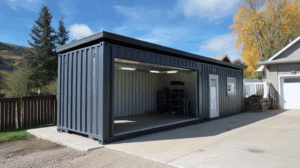Shipping Containers: The New Frontier in Garage Solutions?
Introduction
When it comes to finding innovative and practical solutions for organizing and storing our belongings, the humble garage often gets overlooked. But what if there was a way to transform your garage into a versatile space that not only provides ample storage but also adds a touch of modernity and sustainability? Enter shipping containers – the new frontier in garage solutions. In this blog post, we will explore the numerous benefits of using shipping containers to revolutionize your garage space.
Versatility and Customization
One of the most significant advantages of using shipping containers in garage solutions is their inherent versatility. These containers are available in various sizes and can be easily modified to fit your specific needs. Whether you require extra storage space for tools and equipment or want to create a dedicated workshop or home gym, a shipping container can be customized to meet your requirements.
Moreover, shipping containers can be stacked or arranged in different configurations, allowing you to maximize the use of vertical space in your garage. This flexibility ensures that you can make the most of the available square footage and create a functional and organized environment.
Durability and Security
Shipping containers are designed to withstand the harshest of conditions during long sea voyages, making them incredibly durable and weather-resistant. When repurposed for garage solutions, these containers offer unparalleled protection for your belongings. Whether you live in an area prone to extreme weather or want to safeguard your valuable tools and equipment, a shipping container can provide a secure and reliable storage solution.
Additionally, these containers often come equipped with sturdy locking mechanisms, adding an extra layer of security to your garage. With their reinforced steel walls and robust construction, you can have peace of mind knowing that your possessions are safe from theft and damage.
Sustainability and Cost-effectiveness
In an era where sustainability is of paramount importance, using shipping containers for garage solutions offers an eco-friendly alternative to traditional construction methods. By repurposing these containers, you are reducing waste and giving new life to materials that would otherwise end up in landfills.
Moreover, shipping containers are a cost-effective solution for expanding your garage space. Compared to building an extension or renting additional storage units, investing in a shipping container is a more affordable option. Not only will you save money, but you will also have a customizable and sustainable garage solution that can adapt to your changing needs.
Mobility and Adaptability
One of the lesser-known advantages of using shipping containers in garage solutions is their mobility. If you decide to relocate or need to move your storage space elsewhere on your property, a shipping container can be easily transported without the need for extensive construction or renovation work. This adaptability makes shipping containers an ideal choice for homeowners who value flexibility and versatility.
Conclusion
Shipping containers have emerged as a game-changer in the world of garage solutions. With their versatility, durability, security, sustainability, and cost-effectiveness, these containers offer a unique and practical way to transform your garage into a functional and organized space. Whether you need additional storage, a workshop, or a home gym, shipping containers provide endless possibilities for customization. So why settle for a cluttered and underutilized garage when you can embrace the new frontier of shipping container solutions?
Thinking Outside the Box: Innovative Ways to Utilize Shipping Containers as Garages
When you think of shipping containers, the first thing that comes to mind might be transporting goods across the globe. However, these versatile steel boxes have found a new purpose in recent years – as unique and innovative garages. With their sturdy construction, weatherproof features, and modular design, shipping containers are being repurposed into garages, providing homeowners with a cost-effective and eco-friendly solution. In this blog post, we will explore some creative ways to utilize shipping containers as garages, showcasing the endless possibilities for thinking outside the box.
1. Compact and Efficient Storage
One of the most practical uses for shipping containers as garages is to create compact and efficient storage solutions. Whether you need a dedicated space for your vehicle, tools, or outdoor equipment, a shipping container garage offers ample storage capacity while maximizing the available space. By taking advantage of the container’s height and adding custom shelving or overhead storage, you can optimize every square inch and keep your belongings organized.
2. Customized Workshops
If you’re a DIY enthusiast or have a hobby that requires a dedicated workspace, a shipping container garage can be transformed into a customized workshop. The strong steel walls can serve as a blank canvas for mounting tools, workbenches, and pegboards to create an efficient and organized workspace. With proper insulation and electrical wiring, you can create a comfortable environment for pursuing your passions or even turning your hobby into a small business.
3. Home Office or Studio
In the age of remote work and freelancing, having a separate space for a home office or studio is becoming increasingly essential. Shipping container garages provide a unique opportunity to create your own private workspace without the need for expensive renovations or additions to your home. With natural lighting options, insulation, and soundproofing, you can customize the container to suit your specific needs, whether it’s for writing, painting, photography, or any other creative endeavor.
4. Guest House or Airbnb Rental
For those looking to expand their living space or generate additional income, shipping container garages can be transformed into guest houses or Airbnb rentals. With some modifications and thoughtful design, you can create a comfortable and stylish living space that offers privacy and convenience. Adding windows, insulation, plumbing, and electrical connections can turn a simple garage into a fully functional guest house, providing a unique and cost-effective accommodation option for visitors or potential renters.
5. Mobile Pop-up Shops or Food Trucks
Shipping container garages can also be repurposed into mobile pop-up shops or food trucks, allowing entrepreneurs to take their businesses on the road. The container’s durability, portability, and security features make it an ideal choice for those who want to create a mobile retail or food service experience. By adding foldable or sliding doors, windows, and counters, you can transform the container into an eye-catching and functional space, attracting customers wherever you go.
Conclusion
Gone are the days when shipping containers were solely used for transporting goods. Their robust construction, flexibility, and cost-effectiveness have opened up a world of possibilities for innovative and eco-friendly garage solutions. Whether you’re seeking additional storage space, a customized workshop, a home office, a guest house, or a mobile business, thinking outside the box and repurposing shipping containers as garages can provide you with endless opportunities. So why not embrace this creative trend and turn a shipping container into a functional and unique space that meets your specific needs? The possibilities are limited only by your imagination.
From Cargo to Car Haven: The Pros and Cons of Using a Shipping Container as a Garage
Are you in need of extra storage space or a secure shelter for your vehicles? Look no further than a shipping container. These sturdy steel structures, originally designed for transporting goods across oceans, have gained popularity as a creative and cost-effective solution for various purposes, including serving as a garage. In this article, we’ll explore the pros and cons of using a shipping container as a garage, helping you make an informed decision.
The Pros
1. Affordability
One of the biggest advantages of using a shipping container as a garage is its affordability. Compared to traditional construction methods, shipping containers offer a significantly cheaper alternative. Purchasing and converting a shipping container into a garage is often far more cost-effective than building a conventional garage from scratch.
2. Durability and Security
Shipping containers are built to withstand harsh marine environments, making them incredibly durable structures. Their steel walls are resistant to rust, fire, and pests, ensuring that your vehicles and belongings remain safe and secure. Additionally, containers can be modified to include reinforced doors, locks, and even security systems, providing an extra layer of protection.
3. Portability
Unlike traditional garages, shipping containers offer the advantage of portability. If you ever need to relocate, you can easily transport your container garage to your new location. This flexibility makes shipping container garages an attractive option for those who may move frequently or have temporary storage needs.
4. Customization Options
Shipping containers are highly versatile, allowing for customization to suit your specific needs. Whether you require additional windows, ventilation, insulation, or shelving, containers can be modified to accommodate your preferences. With some creativity and planning, you can transform a simple metal box into a functional and aesthetically pleasing garage.
The Cons
1. Limited Space
While shipping containers offer a decent amount of storage space, they can be limiting in terms of size. Standard containers are typically 8 feet wide and 20 or 40 feet long. If you have multiple vehicles or larger equipment, you may find it challenging to fit everything comfortably within the container. However, it’s worth noting that you can opt for larger containers or consider combining multiple containers if space is a concern.
2. Temperature Control
By default, shipping containers do not provide adequate insulation, making them susceptible to temperature extremes. Without proper insulation, your garage may become uncomfortably hot in the summer and excessively cold in the winter. However, insulation materials can be added to regulate the temperature inside the container, ensuring a more comfortable environment for your vehicles.
3. Planning and Permits
Before setting up a shipping container garage, it’s essential to check local building codes and regulations. Some areas may have specific requirements or restrictions on using shipping containers for residential or commercial purposes. Additionally, obtaining necessary permits may be time-consuming and add to the overall cost of your project. Therefore, it’s crucial to research and consult with local authorities to ensure compliance with all regulations.
4. Aesthetics
While shipping containers can be customized to enhance their visual appeal, some may find it challenging to integrate them seamlessly into their surroundings. If you live in a neighborhood with strict architectural guidelines or have a preference for a specific aesthetic, a shipping container garage may not be the most visually pleasing option. However, with thoughtful landscaping and design choices, it is possible to create an attractive and cohesive look for your property.
Conclusion
Using a shipping container as a garage offers a range of benefits, including affordability, durability, and portability. However, it’s important to consider the limitations, such as limited space, temperature control, planning requirements, and potential aesthetic challenges. By weighing the pros and cons, you can determine if a shipping container garage is the right choice for your storage and vehicle shelter needs. With careful planning and customization, a shipping container can be transformed into a functional and unique garage that suits your requirements.
Unlocking the Potential: Transforming a Shipping Container into the Ultimate Garage
Are you in need of a versatile and functional space to store your vehicles, tools, and equipment? Look no further than a shipping container! These sturdy, weather-resistant structures have long been used for transporting goods across the world, but their potential doesn’t end there. With a little creativity and some elbow grease, you can transform a shipping container into the ultimate garage.
Why Choose a Shipping Container?
Shipping containers offer several advantages over traditional garages, making them an increasingly popular choice among homeowners and businesses alike. Here are a few reasons why you should consider using a shipping container as your garage:
Durability and Security
Shipping containers are built to withstand the harshest weather conditions and heavy loads. Made from corten steel, they are highly durable and resistant to corrosion, ensuring your vehicles and belongings are protected from the elements. Additionally, their solid construction provides an extra layer of security, keeping your valuables safe from theft or vandalism.
Portability and Flexibility
One of the biggest advantages of using a shipping container as a garage is its portability. If you ever need to relocate or expand your garage space, you can simply transport the container to your desired location. Moreover, shipping containers are available in various sizes, allowing you to customize the garage based on your specific needs.
Cost-Effective Solution
Compared to building a traditional garage from scratch, transforming a shipping container into a garage is a cost-effective solution. The container itself serves as the main structure, saving you time and money on construction materials and labor. Additionally, shipping containers are readily available in the market, making it easy to find one that fits your budget.
Transforming a Shipping Container into the Ultimate Garage
Now that you understand the benefits of using a shipping container as a garage, let’s delve into the exciting process of transforming it into the ultimate space for your vehicles and equipment. Here are some key steps to consider:
1. Choose the Right Container
The first step is to select a shipping container that suits your needs. Consider factors such as size, condition, and features. Containers typically come in lengths of 20 or 40 feet, with standard heights and widths. Assess the space required for your vehicles and any additional storage needs before making a decision.
2. Insulation and Ventilation
To create a comfortable environment inside the container, insulation is essential. Insulating the walls, ceiling, and floor will help regulate temperature and reduce condensation. Additionally, proper ventilation is crucial to prevent moisture buildup and maintain air quality. Install windows, vents, or air conditioning units as needed.
3. Electrical and Lighting
To make your garage functional, you’ll need to install electrical outlets and lighting fixtures. Consult with a professional electrician to ensure proper wiring, outlets, and lighting placement. Consider your power requirements for tools, charging stations, and any other electrical equipment you plan to use.
4. Flooring and Storage Solutions
The container’s original flooring may not be suitable for a garage setting. Consider adding a durable and easy-to-clean flooring option such as epoxy or rubber tiles. To optimize storage space, install shelves, racks, or overhead storage systems. Utilize the container’s vertical space efficiently to maximize storage capacity.
5. Security Measures
While shipping containers provide inherent security, it’s always wise to enhance it further. Consider installing security cameras, motion sensor lights, and a robust locking system to deter potential intruders. Additionally, ensure that your garage is well-lit and easily visible from your property to minimize the risk of theft or vandalism.
6. Customization and Personalization
The beauty of transforming a shipping container into a garage is the opportunity for customization. Add personal touches such as a fresh coat of paint, branding, or customized signage. Create a space that reflects your style and serves as a functional extension of your home or business.
Conclusion
Unlock the potential of a shipping container by transforming it into the ultimate garage. With its durability, flexibility, and cost-effectiveness, a shipping container garage is a practical solution for storing your vehicles, tools, and equipment. Whether you’re a homeowner in need of extra space or a business owner looking for a secure storage solution, a shipping container garage is a versatile option that offers endless possibilities. So, embrace your creativity and embark on the journey of transforming a shipping container into your dream garage.
Revamping Your Parking Space: How to Convert a Shipping Container into a Stylish Garage
Are you tired of your drab and uninspiring parking space? Do you long for a garage that not only protects your vehicle but also adds a touch of style to your property? Look no further! In this blog post, we will explore the incredible world of shipping container conversions and how you can transform one into a chic and functional garage.
The Advantages of Shipping Container Garages
Shipping containers have become increasingly popular in recent years due to their durability, versatility, and sustainability. They are designed to withstand the harshest weather conditions, making them an excellent choice for protecting your vehicle. Moreover, repurposing a shipping container as a garage is an eco-friendly solution that reduces waste and minimizes the need for new construction materials.
Planning and Preparation
Before diving into your shipping container garage project, it is essential to plan and prepare adequately. Here are a few key considerations:
1. Permits and Regulations
Check with your local authorities to determine if any permits or regulations apply to your shipping container conversion project. Some areas may have specific requirements regarding the modification and placement of shipping containers on residential properties.
2. Size and Configuration
Evaluate the size and configuration of your shipping container to ensure it can accommodate your vehicle comfortably. Standard shipping containers are typically 20 or 40 feet long, with a width of 8 feet. Consider whether you need additional space for storage or workspace within the garage.
3. Insulation and Ventilation
As shipping containers are made of steel, proper insulation and ventilation are crucial to prevent extreme temperature fluctuations and condensation buildup. Insulating the walls, ceiling, and floor will help maintain a comfortable environment for both you and your vehicle.
Converting the Shipping Container
Now that you have the necessary groundwork in place, it’s time to convert your shipping container into a stylish garage. Here are some steps to follow:
1. Foundation and Site Preparation
Begin by preparing the ground where you plan to place your shipping container garage. Ensure the area is level and stable, as this will provide a solid foundation. You may choose to place the container directly on the ground or utilize a concrete pad or piers for added stability.
2. Entry and Access
Decide on the type and placement of the entry points for your garage. Consider adding a traditional garage door for easy vehicle access and a smaller side entry for pedestrian use. This will provide convenience and flexibility when entering and exiting the space.
3. Insulation and Ventilation
As mentioned earlier, insulation is crucial for temperature control within your garage. Consider using spray foam insulation or insulating panels to keep the interior comfortable. Additionally, install windows or vents strategically to ensure proper airflow and ventilation.
4. Lighting and Electrical
Proper lighting is essential for both functionality and aesthetics. Install sufficient lighting fixtures to illuminate the entire garage space. Additionally, consult with a licensed electrician to ensure your electrical system meets safety standards and can handle the power requirements of your garage.
5. Flooring and Finishes
Choose a flooring option that is durable, easy to clean, and can withstand the weight of your vehicle. Concrete, epoxy coatings, or rubber flooring are popular choices for shipping container garages. Consider adding finishing touches such as paint, wall coverings, or storage solutions to enhance the overall appearance and functionality of your space.
The Final Touches
Once the main construction is complete, it’s time to add the final touches that will take your shipping container garage to the next level:
1. Landscaping
Enhance the aesthetics of your parking space by incorporating landscaping elements around your garage. Planting trees, shrubs, or adding decorative stones can create a visually appealing environment that complements the stylish design of your shipping container.
2. Security Measures
To ensure the safety of your vehicle and belongings, consider installing security measures such as motion sensor lighting, surveillance cameras, or an alarm system. These additions will provide peace of mind and protect your investment.
3. Personalization and Design
Don’t forget to infuse your personality into the design of your garage. Add personalized décor, artwork, or a custom paint job to make your shipping container garage truly unique and reflective of your style.
Conclusion
Revamping your parking space by converting a shipping container into a stylish garage is an innovative and eco-friendly solution. By following the steps outlined in this blog post and adding your personal touch, you can create a functional and aesthetically pleasing space that not only protects your vehicle but also becomes a standout feature of your property. So, get ready to roll up your sleeves and embark on this exciting DIY project that will elevate your parking experience to a whole new level!




